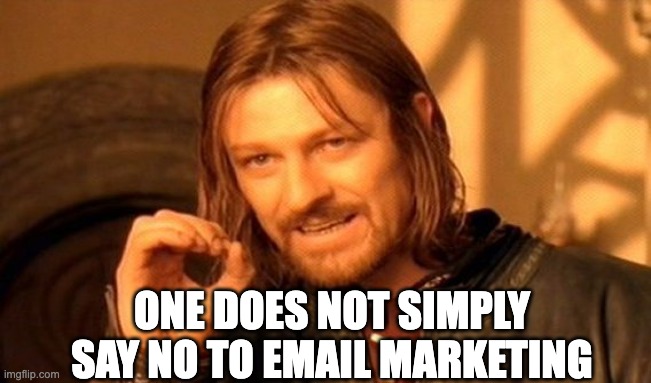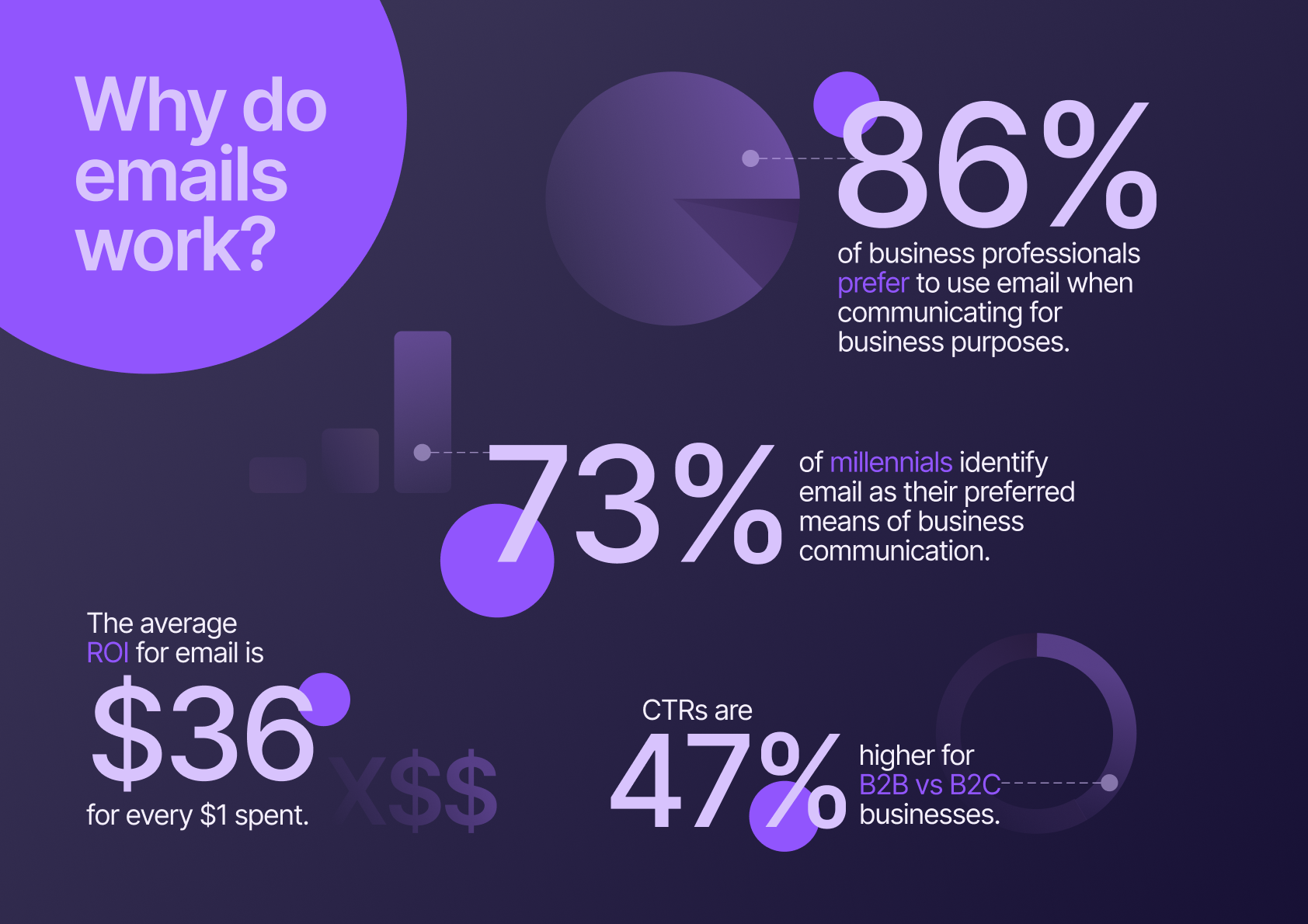Digital marketing has boomed in the past few years, leaving modern digital marketers wondering which channel to use. With a plethora of options to choose from, one might ask, "Does email marketing work?" Despite the rise of other digital marketing channels, email marketing can still be highly effective when tailored to the audience's interests and when marketers avoid overwhelming subscribers with excessive emails.
Now, with a resounding YES, we’re set to dive deep into understanding the world of email marketing and what it entails.

What is email marketing?
Email marketing is a powerful digital marketing strategy businesses use to send emails to prospects and customers. Effective email marketing converts prospects into customers and turns one-time buyers into loyal, raving fans.
For email marketers, this strategy revolves around sending emails and developing relationships with prospects and customers. It’s a crucial part of a comprehensive marketing strategy due to its effectiveness in driving conversions and building brand loyalty. Reliable deliverability ensures emails reach subscribers' inboxes, and effective segmentation can significantly improve engagement and revenue outcomes.
Why does email marketing remain effective?
Direct access to target audience: The success of email marketing lies in its effectiveness despite the rise of other digital marketing channels. Email marketing allows businesses to segment their audiences and tailor messages to meet the interests of different demographics.
Improved conversion rates: Companies using targeted email campaigns report significant conversions.
Low cost with high ROI: Email marketing is known for its low cost and high return on investment. Businesses can reach a large number of consumers at a rate of nearly nothing per message.
Analytics and optimisation: Advanced email marketing tools allow businesses to track open rates, click-through rates, and conversions, allowing them to measure success and optimise future campaigns effectively.
Key benefits of email marketing campaigns
It's a part of everyday life
When was the last time you checked your email? Almost every day, right? Between your mobile devices, laptop, and tablet, emails have become part and parcel of every device.
Has higher conversion rates and email marketing ROI
Email has steadily shown a higher conversion rate than other online marketing strategies because there is a lot of potential to drive users towards a buying decision.
Cost-effectiveness
Compared to traditional print and media, email is much cheaper and also provides better returns. Utilising email marketing templates can significantly reduce costs while developing stellar content and designs for emails and newsletters. Plus, you can take the traditional concept to digital in email marketing, using editable flyer templates and share via email to reach a wider audience, driving engagement according to your need
Tracking capabilities
Email open rates, CTRs, and conversion rates are all easily measurable with the right email marketing tool, which makes it easy to plan campaigns and understand their exact impact.
Segmentation email lists
Persona differentiation and geographical segmentation allow businesses to personalize communication to the tee, keeping communication crisp and relevant to the end user. Integrating an email verifier into this approach ensures accurate targeting, while the right email service providers offer advanced tools for segmentation and personalization. Together, these strategies can boost both sales and customer retention by delivering highly relevant content to verified audiences.
Automation
Email marketing allows for a lot of automation, which frees up your time to focus on other email tactics like detailed newsletters, etc. Starting from a welcome email, mapping your user’s journey on your website, and sending them targeted messaging based on their behaviour can help deliver a very positive user experience without unnecessary clutter and spam.
Automation tools, like autoresponders, play a crucial role in developing successful email marketing campaigns by facilitating personalised communication and streamlining the marketing process.
Using lead magnets and signup forms
Lead magnets are essential tools in email marketing, designed to attract potential customers by offering something valuable in exchange for their email address. Whether it’s a free ebook, a webinar, or exclusive access to a product launch, these incentives can effectively grow your email list with quality subscribers who are likely interested in what you offer.
Integrating signup forms on your website, social media platforms, or even within articles ensures that there’s always a clear path to connect deeper whenever potential customers interact with your brand.
Additionally, having a clear CTA (call to action) in these forms directs the reader to specific actions, making it easier to convert interest into engagement.
Importance of Email List Hygiene and managing bounce rate
Maintaining your email list’s health is crucial for your marketing efforts’ success. Regularly cleaning your email list ensures you send messages to engaged and interested users. This practice improves deliverability rates by reducing bounces, as internet service providers (ISPs) are more likely to flag bulk emails as spam if sent from personal email accounts rather than dedicated email service providers. It also helps segment the list to tailor the communication based on user behaviour and preferences.
Impact of marketing automation and AI
Automation efficiency: Marketing automation tools have revolutionised email marketing by allowing for real-time content customization and scheduling, reducing manual effort, and increasing campaign effectiveness.
Predictive analysis: AI enhances this by predicting the best times to send emails and suggesting content modifications based on user engagement patterns, significantly improving open and click-through rates.
Personalisation at scale: With AI, emails are not just personalised but contextualised, making them relevant to the user's current needs and actions.
Emails are the fulcrum of your communication seesaw
From user journeys to product updates, transactional email and other transactional messages to full-fledged campaigns, festivals, and so much more, marketing emails are the main communication vehicle.
Another major advantage of sending emails is that they stay in the inbox until deleted and can be found again, unlike other notifications or social media updates, which might not be retrievable again.
Three fundamental rules will help you quickly improve your email marketing strategy.
A really creative subject line
Lower bounce rates with good-quality content
Powerful CTAs that add value to the end user
Email marketing ROI
Email marketing ROI typically refers to the money spent on an email campaign and the returns. Investments in the email include collating high-quality content, collecting an email list, creating targeted email campaigns and the like.

Source: www.wordstream.com
For example, if your campaign earned $1000 after spending $100 on development, you would have an ROI of $9. Essentially, this means that for every dollar you spend on the campaign, you’ve earned a return of $9.
However, no “good ROI” would fit as a template for any business. It depends on the metrics you wish to track for the campaign. A big business might have a lower ROI than a small business, purely owing to scale.
Email is a common and useful tool for businesses to operate on and keep their users engaged. That’s why it’s a big part of Fyno as well: to empower PMs to leverage the power of email marketing to optimise the best possible results.
Conclusion
In conclusion, despite the rise of numerous digital marketing channels, email marketing provides significant value through its ability to drive conversions and deliver measurable results. By effectively utilising segmentation, automation, and personalisation, businesses can ensure that their email marketing efforts remain both cost-effective and impactful, ultimately nurturing leads into loyal customers.
FAQs
1. Does email marketing still work?
Yes, email marketing remains effective because it allows businesses to reach and engage their target audience directly, leading to higher conversion rates and a strong return on investment (ROI).
2. What is email marketing?
Email marketing is a digital strategy where businesses send emails to prospects and customers to build relationships, drive sales, and enhance brand loyalty. An effective email marketing campaign involves developing tailored emails that connect with the audience, drive sales, create value for subscribers, and maintain customer engagement, ultimately leading to better outcomes and return on investment (ROI).
Why is email marketing strategy important for businesses?
Email marketing is important because it offers direct access to your audience, allows for targeted messaging, and delivers a high return on investment, making it a key component of a successful marketing strategy.
4. What are the key benefits of email marketing?
The key benefits of email marketing include its cost-effectiveness, high conversion rates, ability to segment audiences, and the capacity to track and optimize campaigns through detailed analytics.
Additionally, email marketing revenue highlights the significant financial impact of well-executed email campaigns, showcasing impressive ROI and substantial revenue generation, particularly through personalized and automated emails that cater to user behaviour.
5. How does email marketing compare to other marketing channels?
One critical element that contributes to the effectiveness of email marketing is the email subject line. A well-crafted email subject line can significantly influence open rates and overall engagement.
6. Can email marketing be automated?
Yes, email marketing can be automated. This allows businesses to send personalized and timely messages based on user behaviour, which enhances the overall customer experience.
7. What is the role of AI in email marketing?
AI plays a significant role in email marketing by optimizing send times, personalizing content at scale, and predicting user behaviour to improve open and click-through rates.


